|
Size: 30130
Comment:
|
Size: 48431
Comment:
|
| Deletions are marked like this. | Additions are marked like this. |
| Line 4: | Line 4: |
== Divisibility Poset == by William Stein {{{#!sagecell @interact def _(n=(5..100)): Poset(([1..n], lambda x, y: y%x == 0) ).show() }}} {{attachment:divposet.png}} |
|
| Line 7: | Line 18: |
| {{{ | {{{#!sagecell |
| Line 40: | Line 51: |
| g += line([(j*2-len(cur),-i), ((k*2)-len(rows[i-1]),-i+1)], | g += line([(j*2-len(cur),-i), ((k*2)-len(rows[i-1]),-i+1)], |
| Line 61: | Line 72: |
| {{{ | {{{#!sagecell |
| Line 75: | Line 86: |
| {{{ | {{{#!sagecell |
| Line 83: | Line 94: |
| == Prime Spiral - Square == | == Prime Spiral - Square FIXME == |
| Line 85: | Line 96: |
| {{{ | {{{#!sagecell |
| Line 90: | Line 101: |
| REFERENCES: | REFERENCES: |
| Line 95: | Line 106: |
| Weisstein, Eric W. "Prime-Generating Polynomial." From MathWorld--A Wolfram Web Resource. http://mathworld.wolfram.com/Prime-GeneratingPolynomial.html | Weisstein, Eric W. "Prime-Generating Polynomial." From MathWorld--A Wolfram Web Resource. http://mathworld.wolfram.com/Prime-GeneratingPolynomial.html |
| Line 103: | Line 114: |
| elif y<0 and -x >= y and y<x: return 4*(y+1)^2 -11*(y+1) + (start+7) +x | elif y<0 and -x >= y and y<x: return 4*(y+1)^2 -11*(y+1) + (start+7) +x |
| Line 106: | Line 117: |
| #Takes in an n and the start value of the spiral and gives its (x,y) coordinate | #Takes in an n and the start value of the spiral and gives its (x,y) coordinate |
| Line 108: | Line 119: |
| num = num - start +1 | num = num - start +1 |
| Line 110: | Line 121: |
| top = ceil(sqrt(num)) | top = ceil(sqrt(num)) |
| Line 115: | Line 126: |
| else: | else: |
| Line 122: | Line 133: |
| else: | else: |
| Line 134: | Line 145: |
| N = M.copy() | N = copy(M) |
| Line 138: | Line 149: |
| #These functions return an int based on where the t is located in the spiral |
#These functions return an int based on where the t is located in the spiral |
| Line 151: | Line 162: |
| if n !=0: x_cord, y_cord = find_xy(n, start) #Overrides the user given x and y coordinates | if n !=0: x_cord, y_cord = find_xy(n, start) #Overrides the user given x and y coordinates |
| Line 159: | Line 170: |
| Line 162: | Line 173: |
| if show_lines: for t in [(-size-1)..size+1]: |
if show_lines: for t in [(-size-1)..size+1]: |
| Line 165: | Line 176: |
| if m.is_pseudoprime(): main_list.add(m) | if m.is_pseudoprime(): main_list.add(m) |
| Line 170: | Line 181: |
| #This for loop changes the matrix by spiraling out from the center and changing each entry as it goes. It is faster than the find_xy function above. | #This for loop changes the matrix by spiraling out from the center and changing each entry as it goes. It is faster than the find_xy function above. |
| Line 175: | Line 186: |
| else: x-=1 | else: x-=1 |
| Line 177: | Line 188: |
| elif county < overcount: |
elif county < overcount: |
| Line 180: | Line 191: |
| else: y-=1 | else: y-=1 |
| Line 182: | Line 193: |
| else: | else: |
| Line 188: | Line 199: |
| if not invert and num in main_list: |
if not invert and num in main_list: |
| Line 196: | Line 207: |
| if n != 0: |
if n != 0: |
| Line 213: | Line 224: |
| else: | else: |
| Line 222: | Line 233: |
| {{{ @interact def polar_prime_spiral(start=1, end=2000, show_factors = false, highlight_primes = false, show_curves=true, n = 0): #For more information about the factors in the spiral, visit http://www.dcs.gla.ac.uk/~jhw/spirals/index.html by John Williamson. |
{{{#!sagecell @interact def polar_prime_spiral(start=1, end=2000, show_factors = false, highlight_primes = false, show_curves=true, n = 0): #For more information about the factors in the spiral, visit http://www.dcs.gla.ac.uk/~jhw/spirals/index.html by John Williamson. |
| Line 232: | Line 243: |
| Line 240: | Line 251: |
| R = points(list2, alpha = .1) #Faded Composites else: |
R = points(list2, alpha = .1) #Faded Composites else: |
| Line 248: | Line 259: |
| R=points(list2, hue = .1, pointsize = p_size) |
R=points(list2, hue = .1, pointsize = p_size) |
| Line 252: | Line 263: |
| Line 259: | Line 270: |
| Q = plot(W1+W2+W3+W4, alpha = .1) | Q = plot(W1+W2+W3+W4, alpha = .1) |
| Line 262: | Line 273: |
| if show_curves: | if show_curves: |
| Line 267: | Line 278: |
| if n > (floor(sqrt(n)))^2 and n <= (floor(sqrt(n)))^2 + floor(sqrt(n)): | if n > (floor(sqrt(n)))^2 and n <= (floor(sqrt(n)))^2 + floor(sqrt(n)): |
| Line 270: | Line 281: |
| else: | else: |
| Line 275: | Line 286: |
| def g(m): return (a*m^2+b*m+c); | def g(m): return (a*m^2+b*m+c); |
| Line 281: | Line 292: |
| c= c2; | c= c2; |
| Line 296: | Line 307: |
| {{{ j = 0 @interact def _(N=[1..100], k=selector([2,4,..,12],nrows=1), prec=(3..40), |
{{{#!sagecell @interact def _(N=[1..100], k=selector([2,4,..,12],nrows=1), prec=(3..40), |
| Line 302: | Line 312: |
| print j; global j; j += 1 | |
| Line 319: | Line 328: |
| {{{ | {{{#!sagecell |
| Line 332: | Line 341: |
| {{{ | {{{#!sagecell |
| Line 340: | Line 349: |
| G = Graph(T, multiedges=True, loops=not three_d) | G = DiGraph(T, multiedges=not three_d) if three_d: G.remove_loops() |
| Line 353: | Line 364: |
| == Quadratic Residue Table == | == Quadratic Residue Table FIXME == |
| Line 355: | Line 366: |
| {{{ | {{{#!sagecell |
| Line 406: | Line 417: |
| == Cubic Residue Table == | == Cubic Residue Table FIXME == |
| Line 408: | Line 419: |
| {{{ | {{{#!sagecell |
| Line 426: | Line 437: |
| if Mod(a,3)!=0 and Mod(b,3)==0: return True else: return False |
return Mod(a,3)!=0 and Mod(b,3)==0 |
| Line 464: | Line 472: |
| MP += line([(i,0),(i,r)], rgbcolor='black') | MP += line([(i,0),(i,r)], rgbcolor='black') |
| Line 492: | Line 500: |
| {{{ | {{{#!sagecell |
| Line 541: | Line 549: |
| S = circle((0,0),1,rgbcolor='yellow') \ + line([e_pt,e_gs_pt], rgbcolor='red', thickness=4) \ + line([f_pt,f_gs_pt], rgbcolor='blue', thickness=3) \ + line([ef_pt,ef_gs_pt], rgbcolor='purple',thickness=2) \ + point(e_pt,pointsize=50, rgbcolor='red') \ + point(f_pt,pointsize=50, rgbcolor='blue') \ + point(ef_pt,pointsize=50,rgbcolor='purple') \ + point(f_gs_pt,pointsize=75, rgbcolor='black') \ + point(e_gs_pt,pointsize=75, rgbcolor='black') \ + point(ef_gs_pt,pointsize=75, rgbcolor='black') \ + point(js_pt,pointsize=100,rgbcolor='green') |
S = circle((0,0),1,rgbcolor='yellow') S += line([e_pt,e_gs_pt], rgbcolor='red', thickness=4) S += line([f_pt,f_gs_pt], rgbcolor='blue', thickness=3) S += line([ef_pt,ef_gs_pt], rgbcolor='purple',thickness=2) S += point(e_pt,pointsize=50, rgbcolor='red') S += point(f_pt,pointsize=50, rgbcolor='blue') S += point(ef_pt,pointsize=50,rgbcolor='purple') S += point(f_gs_pt,pointsize=75, rgbcolor='black') S += point(e_gs_pt,pointsize=75, rgbcolor='black') S += point(ef_gs_pt,pointsize=75, rgbcolor='black') S += point(js_pt,pointsize=100,rgbcolor='green') |
| Line 553: | Line 561: |
| S += text('$J(%s,%s) = %s$'%(latex2(e),latex2(f),latex(js)), \ | S += text('$J(%s,%s) = %s$'%(latex2(e),latex2(f),latex(js)), |
| Line 572: | Line 580: |
| {{{ | {{{#!sagecell |
| Line 621: | Line 629: |
| S = circle((0,0),1,rgbcolor='yellow') \ + line([e_pt,e_gs_pt], rgbcolor='red', thickness=4) \ + line([f_pt,f_gs_pt], rgbcolor='blue', thickness=3) \ + line([ef_pt,ef_gs_pt], rgbcolor='purple',thickness=2) \ + point(e_pt,pointsize=50, rgbcolor='red') \ + point(f_pt,pointsize=50, rgbcolor='blue') \ + point(ef_pt,pointsize=50,rgbcolor='purple') \ + point(f_gs_pt,pointsize=75, rgbcolor='black') \ + point(e_gs_pt,pointsize=75, rgbcolor='black') \ + point(ef_gs_pt,pointsize=75, rgbcolor='black') \ + point(js_pt,pointsize=100,rgbcolor='green') |
S = circle((0,0),1,rgbcolor='yellow') S += line([e_pt,e_gs_pt], rgbcolor='red', thickness=4) S += line([f_pt,f_gs_pt], rgbcolor='blue', thickness=3) S += line([ef_pt,ef_gs_pt], rgbcolor='purple',thickness=2) S += point(e_pt,pointsize=50, rgbcolor='red') S += point(f_pt,pointsize=50, rgbcolor='blue') S += point(ef_pt,pointsize=50,rgbcolor='purple') S += point(f_gs_pt,pointsize=75, rgbcolor='black') S += point(e_gs_pt,pointsize=75, rgbcolor='black') S += point(ef_gs_pt,pointsize=75, rgbcolor='black') S += point(js_pt,pointsize=100,rgbcolor='green') |
| Line 633: | Line 641: |
| S += text('$J(%s,%s) = %s$'%(latex2(e),latex2(f),latex(js)), \ | S += text('$J(%s,%s) = %s$'%(latex2(e),latex2(f),latex(js)), |
| Line 645: | Line 653: |
| ga[i].save('j%d.PNG'%i,figsize=4,aspect_ratio=1, \ | ga[i].save('j%d.png'%i,figsize=4,aspect_ratio=1, |
| Line 651: | Line 659: |
| html('<table bgcolor=lightgrey cellpadding=2>') | s='<table bgcolor=lightgrey cellpadding=2>' |
| Line 653: | Line 661: |
| html('<tr><td align="center"><img src="cell://j%d.PNG"></td>'%(2*i)) html('<td align="center"><img src="cell://j%d.PNG"></td></tr>'%(2*i+1)) html('</table>') }}} |
s+='<tr><td align="center"><img src="cell://j%d.png"></td>'%(2*i) s+='<td align="center"><img src="cell://j%d.png"></td></tr>'%(2*i+1) s+='</table>' html(s)}}} |
| Line 664: | Line 672: |
| {{{ | {{{#!sagecell |
| Line 670: | Line 678: |
| else: | else: |
| Line 677: | Line 685: |
def line_from_curve_points(E,P,Q,style='-',rgb=(1,0,0),length=25): """ P,Q two points on an elliptic curve. Output is a graphic representation of the straight line intersecting with P,Q. """ # The function tangent to P=Q on E if P == Q: if P[2]==0: return line([(1,-length),(1,length)],linestyle=style,rgbcolor=rgb) else: # Compute slope of the curve E in P l=-(3*P[0]^2 + 2*E.a2()*P[0] + E.a4() - E.a1()*P[1])/((-2)*P[1] - E.a1()*P[0] - E.a3()) f(x) = l * (x - P[0]) + P[1] return plot(f(x),-length,length,linestyle=style,rgbcolor=rgb) # Trivial case of P != R where P=O or R=O then we get the vertical line from the other point elif P[2] == 0: return line([(Q[0],-length),(Q[0],length)],linestyle=style,rgbcolor=rgb) elif Q[2] == 0: return line([(P[0],-length),(P[0],length)],linestyle=style,rgbcolor=rgb) # Non trivial case where P != R else: # Case where x_1 = x_2 return vertical line evaluated in Q if P[0] == Q[0]: return line([(P[0],-length),(P[0],length)],linestyle=style,rgbcolor=rgb) #Case where x_1 != x_2 return line trough P,R evaluated in Q" l=(Q[1]-P[1])/(Q[0]-P[0]) f(x) = l * (x - P[0]) + P[1] return plot(f(x),-length,length,linestyle=style,rgbcolor=rgb) |
|
| Line 679: | Line 718: |
| curve = E.plot(rgbcolor = (0,0,1),xmin=25,xmax=25,plot_points=300) | curve = E.plot(rgbcolor = (0,0,1),xmin=-5,xmax=5,plot_points=300) |
| Line 705: | Line 744: |
def line_from_curve_points(E,P,Q,style='-',rgb=(1,0,0),length=25): """ P,Q two points on an elliptic curve. Output is a graphic representation of the straight line intersecting with P,Q. """ # The function tangent to P=Q on E if P == Q: if P[2]==0: return line([(1,-length),(1,length)],linestyle=style,rgbcolor=rgb) else: # Compute slope of the curve E in P l=-(3*P[0]^2 + 2*E.a2()*P[0] + E.a4() - E.a1()*P[1])/((-2)*P[1] - E.a1()*P[0] - E.a3()) f(x) = l * (x - P[0]) + P[1] return plot(f(x),-length,length,linestyle=style,rgbcolor=rgb) # Trivial case of P != R where P=O or R=O then we get the vertical line from the other point elif P[2] == 0: return line([(Q[0],-length),(Q[0],length)],linestyle=style,rgbcolor=rgb) elif Q[2] == 0: return line([(P[0],-length),(P[0],length)],linestyle=style,rgbcolor=rgb) # Non trivial case where P != R else: # Case where x_1 = x_2 return vertical line evaluated in Q if P[0] == Q[0]: return line([(P[0],-length),(P[0],length)],linestyle=style,rgbcolor=rgb) #Case where x_1 != x_2 return line trough P,R evaluated in Q" l=(Q[1]-P[1])/(Q[0]-P[0]) f(x) = l * (x - P[0]) + P[1] return plot(f(x),-length,length,linestyle=style,rgbcolor=rgb) |
|
| Line 740: | Line 749: |
| {{{ | {{{#!sagecell |
| Line 755: | Line 764: |
| {{{ | {{{#!sagecell |
| Line 769: | Line 778: |
| print """ <html> |
html(""" |
| Line 794: | Line 802: |
| </ol></html> """ % (bits, p, g, a, g, a, p, (g^a), b, g, b, p, (g^b), (g^b), a, p, (g^ b)^a, g^a, b, p, (g^a)^b) |
</ol> """ % (bits, p, g, a, g, a, p, (g^a), b, g, b, p, (g^b), (g^b), a, p, (g^ b)^a, g^a, b, p, (g^a)^b)) |
| Line 806: | Line 814: |
| {{{ @interact def _(number=e, ymax=selector([None,5,20,..,400],nrows=2), clr=Color('purple'), prec=[500,1000,..,5000]): |
{{{#!sagecell @interact def _(number=e, ymax=selector([5,20,..,400],nrows=2), clr=Color('purple'), prec=[500,1000,..,5000]): |
| Line 816: | Line 824: |
| {{{ | {{{#!sagecell |
| Line 837: | Line 845: |
| {{{ | {{{#!sagecell |
| Line 845: | Line 853: |
| def _(gen = selector(['t+1', 't-1', '-1/t'], nrows=1)): | def _(gen = selector(['t+1', 't-1', '-1/t'], buttons=True,nrows=1)): |
| Line 863: | Line 871: |
= Multiple Zeta Values = by Akhilesh P. == Computing Multiple Zeta values (Euler-Zagier numbers) == === Word Input === {{{#!sagecell R=RealField(10) @interact def _( weight=(5,(2..100))): n=weight a=[0 for i in range(n-1)] a.append(1) @interact def _(v=('word', input_grid(1, n, default=[a], to_value=lambda x: vector(flatten(x)))), accuracy=(100..100000)): D=accuracy a=[v[i] for i in range(len(v))] DD=int(3.321928*D)+int(R(log(3.321928*D))/R(log(10)))+4 RIF=RealIntervalField(DD) def Li(word): n=int(DD*log(10)/log(2))+1 B=[] L=[] S=[] count=-1 k=len(word) for i in range(k): B.append(RIF('0')) L.append(RIF('0')) if(word[i]==1 and i<k-1): S.append(RIF('0')) count=count+1 T=RIF('1') for m in range(n): T=T/2 B[k-1]=RIF('1')/(m+1) j=count for i in range(k-2,-1,-1): if(word[i]==0): B[i]=B[i+1]/(m+1) elif(word[i]==1): B[i]=S[j]/(m+1) S[j]=S[j]+B[i+1] j=j-1 L[i]=T*B[i]+L[i] L[k-1]=T*B[k-1]+L[k-1] return(L) def dual(a): b=list() b=a b=b[::-1] for i in range(len(b)): b[i]=1-b[i] return(b) def zeta(a): b=dual(a) l1=Li(a)+[1] l2=Li(b)+[1] Z=RIF('0') for i in range(len(l1)): Z=Z+l1[i]*l2[len(a)-i] return(Z) u=zeta(a) RIF=RealIntervalField(int(3.321928*D)) u=u/1 print u }}} {{attachment:akhi1.png}} === Composition Input === {{{#!sagecell R=RealField(10) @interact def _( Depth=(5,(2..100))): n=Depth a=[2] a=a+[1 for i in range(n-1)] @interact def _(v=('Composition', input_grid(1, n, default=[a], to_value=lambda x: vector(flatten(x)))), accuracy=(100..100000)): D=accuracy a=[v[i] for i in range(len(v))] def comptobin(a): word=[] for i in range(len(a)): word=word+[0]*(a[i]-1)+[1] return(word) a=comptobin(a) DD=int(3.321928*D)+int(R(log(3.321928*D))/R(log(10)))+4 RIF=RealIntervalField(DD) def Li(word): n=int(DD*log(10)/log(2))+1 B=[] L=[] S=[] count=-1 k=len(word) for i in range(k): B.append(RIF('0')) L.append(RIF('0')) if(word[i]==1 and i<k-1): S.append(RIF('0')) count=count+1 T=RIF('1') for m in range(n): T=T/2 B[k-1]=RIF('1')/(m+1) j=count for i in range(k-2,-1,-1): if(word[i]==0): B[i]=B[i+1]/(m+1) elif(word[i]==1): B[i]=S[j]/(m+1) S[j]=S[j]+B[i+1] j=j-1 L[i]=T*B[i]+L[i] L[k-1]=T*B[k-1]+L[k-1] return(L) def dual(a): b=list() b=a b=b[::-1] for i in range(len(b)): b[i]=1-b[i] return(b) def zeta(a): b=dual(a) l1=Li(a)+[1] l2=Li(b)+[1] Z=RIF('0') for i in range(len(l1)): Z=Z+l1[i]*l2[len(a)-i] return(Z) u=zeta(a) RIF=RealIntervalField(int(3.321928*D)) u=u/1 print u }}} {{attachment:akhi5.png}} == Program to Compute Integer Relation between Multiple Zeta Values (Euler-Zagier numbers) == {{{#!sagecell from mpmath import * print "Enter the number of composition" @interact def _( n=(5,(2..100))): a=[] for i in range(n): a.append([i+2,1]) print "In each box Enter composition as an array" @interact def _(v=('Compositions', input_box( default=a, to_value=lambda x: vector(flatten(x)))), accuracy=(100..100000)): D=accuracy R=RealField(10) a=v def comptobin(a): word=[] for i in range(len(a)): word=word+[0]*(a[i]-1)+[1] return(word) DD=int(D)+int(R(log(3.321928*D))/R(log(10)))+4 RIF=RealIntervalField(DD) mp.dps=DD def Li(word): n=int(DD*log(10)/log(2))+1 B=[] L=[] S=[] count=-1 k=len(word) for i in range(k): B.append(mpf('0')) L.append(mpf('0')) if(word[i]==1 and i<k-1): S.append(mpf('0')) count=count+1 T=mpf('1') for m in range(n): T=T/2 B[k-1]=mpf('1')/(m+1) j=count for i in range(k-2,-1,-1): if(word[i]==0): B[i]=B[i+1]/(m+1) elif(word[i]==1): B[i]=S[j]/(m+1) S[j]=S[j]+B[i+1] j=j-1 L[i]=T*B[i]+L[i] L[k-1]=T*B[k-1]+L[k-1] return(L) def dual(a): b=list() b=a b=b[::-1] for i in range(len(b)): b[i]=1-b[i] return(b) def zeta(a): b=dual(a) l1=Li(a)+[1] l2=Li(b)+[1] Z=mpf('0') for i in range(len(l1)): Z=Z+l1[i]*l2[len(a)-i] return(Z) zet=[] for i in range(n): zet.append((zeta(comptobin(a[i])))) mp.dps=D for i in range(n): zet[i]=zet[i]/1 print "zeta(",a[i],")=",zet[i] u=pslq(zet,tol=10**-D,maxcoeff=100,maxsteps=10000) print "the Intger Relation between the above zeta values given by the vector" print u }}} {{attachment:akhi10.png}} == Word to composition == {{{#!sagecell @interact def _( weight=(7,(2..100))): n=weight a=[0 for i in range(n-1)] a.append(1) @interact def _(v=('word', input_grid(1, n, default=[a], to_value=lambda x: vector(flatten(x))))): a=[v[i] for i in range(len(v))] def bintocomp(a): b=[] count=1 for j in range(len(a)): if(a[j]==0): count=count+1 else: b.append(count) count=1 return(b) print "Composition is ",bintocomp(a) }}} {{attachment:akhi2.png}} == Composition to Word == {{{#!sagecell @interact def _( Depth=(7,(1..100))): n=Depth a=[] a.append(2) a=a+[1 for i in range(1,n)] @interact def _(v=('composition', input_grid(1, n, default=[a], to_value=lambda x: vector(flatten(x))))): a=[v[i] for i in range(len(v))] def comptobin(a): word=[] for i in range(len(a)): word=word+[0]*(a[i]-1)+[1] return(word) print "Word is ",comptobin(a) }}} {{attachment:akhi3.png}} == Dual of a Word == {{{#!sagecell @interact def _( weight=(7,(2..100))): n=weight a=[0 for i in range(n-1)] a.append(1) @interact def _(v=('word', input_grid(1, n, default=[a], to_value=lambda x: vector(flatten(x))))): a=[v[i] for i in range(len(v))] def dual(a): b=list() b=a b=b[::-1] for i in range(len(b)): b[i]=1-b[i] return(b) print "Dual word is ",dual(a) }}} {{attachment:akhi4.png}} == Shuffle product of two Words == {{{#!sagecell @interact def _( w1=(2,(2..100)), w2=(2,(2..100))): a=[0] b=[0 for i in range(w2-1)] a=a+[1 for i in range(1,w1)] b=b+[1] import itertools #this program gives the list of all binary words of weight n and depth k @interact def _(v1=('word1', input_grid(1, w1, default=[a], to_value=lambda x: vector(flatten(x)))), v2=('word2', input_grid(1, w2, default=[b], to_value=lambda x: vector(flatten(x))))): a=[v1[i] for i in range(len(v1))] b=[v2[i] for i in range(len(v2))] def kbits(n, k): result = [] for bits in itertools.combinations(range(n), k): s = ['0'] * n for bit in bits: s[bit] = '1' result.append(''.join(s)) return result def sort(a,l,m): b=[] n=len(a) for i in range(n): b.append(a[i]) for j in range(l-1,-1,-1): k=0 for t in range(m+1): for i in range(n): if(a[i][j]== t): b[k]=a[i] k=k+1 for i in range(n): a[i]=b[i] return(a) def count(a): n=len(a) b=[] b.append(a[0]) m=[] m.append(1) c=0 for i in range(1,n): if(a[i]==a[i-1]): m[c]=m[c]+1 else: b.append(a[i]) m.append(1) c=c+1 return(b,m) def shuffle(a,b): r=len(a) s=len(b) # Generating an array of strings containing all combinations of weight r+s and depth s M=kbits(r+s,s) n=len(M) a1= [] for i in range(n): a1.append(list(M[i])) # The zeroes are replaced by the entries of a and the ones by the entries of b a2= [] for i in range(n): a2.append([]) count0=0 count1=0 for j in range(s+r): if(a1[i][j]=='0'): a2[i].append(a[count0]) count0=count0+1 if(a1[i][j]=='1'): a2[i].append(b[count1]) count1=count1+1 # Reordering in lexicographic order the entries of a2: this is done by first reordering them according to the last digit, then the next to last digit, etc a3=sort(a2,r+s,max(a+b+[0])) # Getting the same list without repetitions and with multiplicities a4=count(a3) return(a4) c=shuffle(a,b) for i in range(len(c[0])-1): print c[1][i],"*",c[0][i] ,"+ ", print c[1][len(c[0])-1],"*",c[0][len(c[0])-1] }}} {{attachment:akhi6.png}} == Shuffle Regularization at 0 == {{{#!sagecell @interact def _( w=(2,(2..100))): a=[0] a=a+[1 for i in range(1,w)] import itertools #this program gives the list of all binary words of weight n and depth k @interact def _(v=('word', input_grid(1, w, default=[a], to_value=lambda x: vector(flatten(x))))): a=[v[i] for i in range(len(v))] def kbits(n, k): result = [] for bits in itertools.combinations(range(n), k): s = ['0'] * n for bit in bits: s[bit] = '1' result.append(''.join(s)) return result def sort(a,l,m): b=[] n=len(a) for i in range(n): b.append(a[i]) for j in range(l-1,-1,-1): k=0 for t in range(m+1): for i in range(n): if(a[i][j]== t): b[k]=a[i] k=k+1 for i in range(n): a[i]=b[i] return(a) def sort1(a,l,m): b=[] b.append([]) b.append([]) n=len(a[0]) for i in range(n): b[0].append(a[0][i]) b[1].append(a[1][i]) for j in range(l-1,-1,-1): k=0 for t in range(m+1): for i in range(n): if(a[0][i][j]== t): b[0][k]=a[0][i] b[1][k]=a[1][i] k=k+1 for i in range(n): a[0][i]=b[0][i] a[1][i]=b[1][i] return(a) def count(a): n=len(a) b=[] b.append(a[0]) m=[] m.append(1) c=0 for i in range(1,n): if(a[i]==a[i-1]): m[c]=m[c]+1 else: b.append(a[i]) m.append(1) c=c+1 return(b,m) def count1(a): n=len(a[0]) b=[] b.append([]) b.append([]) b[0].append(a[0][0]) b[1].append(a[1][0]) c=0 for i in range(1,n): if(a[0][i]==a[0][i-1]): b[1][c]=b[1][c]+a[1][i] else: b[0].append(a[0][i]) b[1].append(a[1][i]) c=c+1 return(b) def shuffle(a,b): r=len(a) s=len(b) # Generating an array of strings containing all combinations of weight r+s and depth s M=kbits(r+s,s) n=len(M) a1= [] for i in range(n): a1.append(list(M[i])) # The zeroes are replaced by the entries of a and the ones by the entries of b a2= [] for i in range(n): a2.append([]) count0=0 count1=0 for j in range(s+r): if(a1[i][j]=='0'): a2[i].append(a[count0]) count0=count0+1 if(a1[i][j]=='1'): a2[i].append(b[count1]) count1=count1+1 # Reordering in lexicographic order the entries of a2: this is done by first reordering them according to the last digit, then the next to last digit, etc a3=sort(a2,r+s,max(a+b+[0])) # Getting the same list without repetitions and with multiplicities a4=count(a3) return(a4) def Regshuf0(a): r=[] r.append([]) r.append([]) t=0 c=1 for i in range(len(a)+1): if(t==0): b=shuffle(a[:len(a)-i],a[len(a)-i:]) for j in range(len(b[0])): r[0].append(b[0][j]) r[1].append(b[1][j]*c) c=-c if(i<len(a)): if(a[len(a)-1-i]==1): t=1 r=sort1(r,len(a),max(a+[0])) r=count1(r) rg=[] rg.append([]) rg.append([]) for i in range(len(r[0])): if(r[1][i] is not 0): rg[0].append(r[0][i]) rg[1].append(r[1][i]) return(rg) c=Regshuf0(a) for i in range(len(c[0])-1): if(c[1][i] != 0): print c[1][i],"*",c[0][i] ,"+ ", if(c[1][len(c[0])-1] != 0): print c[1][len(c[0])-1],"*",c[0][len(c[0])-1] }}} {{attachment:akhi7.png}} == Shuffle Regularization at 1 == {{{#!sagecell @interact def _( w=(2,(2..20))): a=[0] a=a+[1 for i in range(1,w)] import itertools #this program gives the list of all binary words of weight n and depth k @interact def _(v=('word', input_grid(1, w, default=[a], to_value=lambda x: vector(flatten(x))))): a=[v[i] for i in range(len(v))] def kbits(n, k): result = [] for bits in itertools.combinations(range(n), k): s = ['0'] * n for bit in bits: s[bit] = '1' result.append(''.join(s)) return result def sort(a,l,m): b=[] n=len(a) for i in range(n): b.append(a[i]) for j in range(l-1,-1,-1): k=0 for t in range(m+1): for i in range(n): if(a[i][j]== t): b[k]=a[i] k=k+1 for i in range(n): a[i]=b[i] return(a) def sort1(a,l,m): b=[] b.append([]) b.append([]) n=len(a[0]) for i in range(n): b[0].append(a[0][i]) b[1].append(a[1][i]) for j in range(l-1,-1,-1): k=0 for t in range(m+1): for i in range(n): if(a[0][i][j]== t): b[0][k]=a[0][i] b[1][k]=a[1][i] k=k+1 for i in range(n): a[0][i]=b[0][i] a[1][i]=b[1][i] return(a) def count(a): n=len(a) b=[] b.append(a[0]) m=[] m.append(1) c=0 for i in range(1,n): if(a[i]==a[i-1]): m[c]=m[c]+1 else: b.append(a[i]) m.append(1) c=c+1 return(b,m) def count1(a): n=len(a[0]) b=[] b.append([]) b.append([]) b[0].append(a[0][0]) b[1].append(a[1][0]) c=0 for i in range(1,n): if(a[0][i]==a[0][i-1]): b[1][c]=b[1][c]+a[1][i] else: b[0].append(a[0][i]) b[1].append(a[1][i]) c=c+1 return(b) def shuffle(a,b): r=len(a) s=len(b) # Generating an array of strings containing all combinations of weight r+s and depth s M=kbits(r+s,s) n=len(M) a1= [] for i in range(n): a1.append(list(M[i])) # The zeroes are replaced by the entries of a and the ones by the entries of b a2= [] for i in range(n): a2.append([]) count0=0 count1=0 for j in range(s+r): if(a1[i][j]=='0'): a2[i].append(a[count0]) count0=count0+1 if(a1[i][j]=='1'): a2[i].append(b[count1]) count1=count1+1 # Reordering in lexicographic order the entries of a2: this is done by first reordering them according to the last digit, then the next to last digit, etc a3=sort(a2,r+s,max(a+b+[0])) # Getting the same list without repetitions and with multiplicities a4=count(a3) return(a4) def Regshuf1(a): r=[] r.append([]) r.append([]) t=0 c=1 for i in range(len(a)+1): if(t==0): b=shuffle(a[:i],a[i:]) for j in range(len(b[0])): r[0].append(b[0][j]) r[1].append(b[1][j]*c) c=-c if(i<len(a)): if(a[i]==0): t=1 r=sort1(r,len(a),max(a+[0])) r=count1(r) rg=[] rg.append([]) rg.append([]) for i in range(len(r[0])): if(r[1][i] is not 0): rg[0].append(r[0][i]) rg[1].append(r[1][i]) return(rg) c=Regshuf1(a) for i in range(len(c[0])-1): if(c[1][i] != 0): print c[1][i],"*",c[0][i] ,"+ ", if(c[1][len(c[0])-1] != 0): print c[1][len(c[0])-1],"*",c[0][len(c[0])-1] }}} {{attachment:akhi8.png}} |
Contents
- Integer Factorization
- Prime Numbers
- Modular Forms
- Modular Arithmetic
- Cyclotomic Fields
- Elliptic Curves
- Cryptography
- Other
- Multiple Zeta Values
Integer Factorization
Divisibility Poset
by William Stein
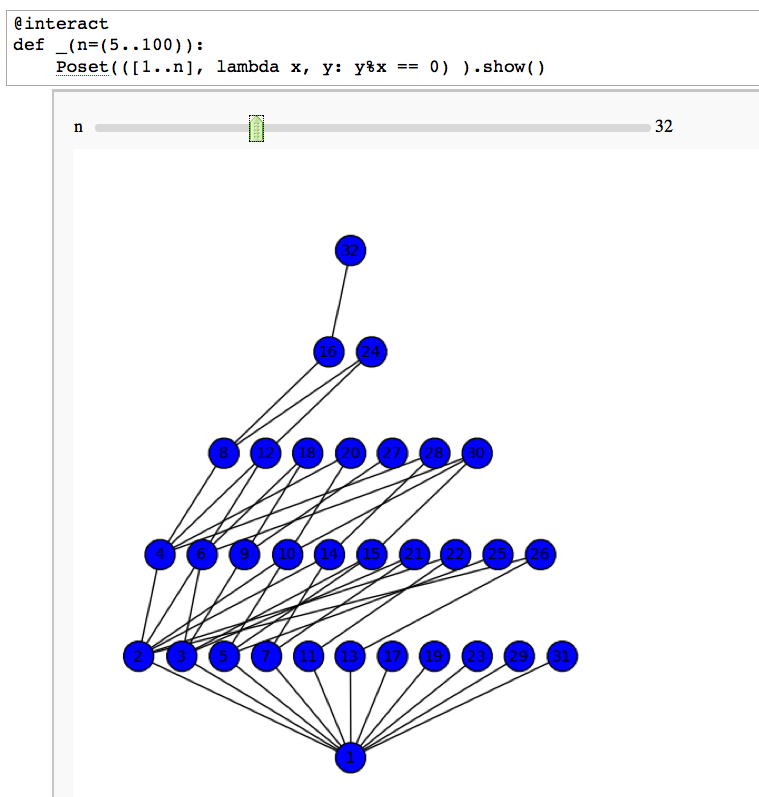
Factor Trees
by William Stein
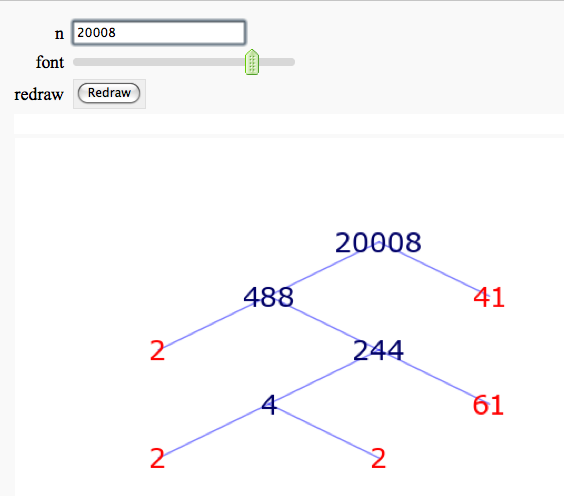
More complicated demonstration using Mathematica: http://demonstrations.wolfram.com/FactorTrees/
Factoring an Integer
by Timothy Clemans
Sage implementation of the Mathematica demonstration of the same name. http://demonstrations.wolfram.com/FactoringAnInteger/
Prime Numbers
Illustrating the prime number theorem
by William Stein
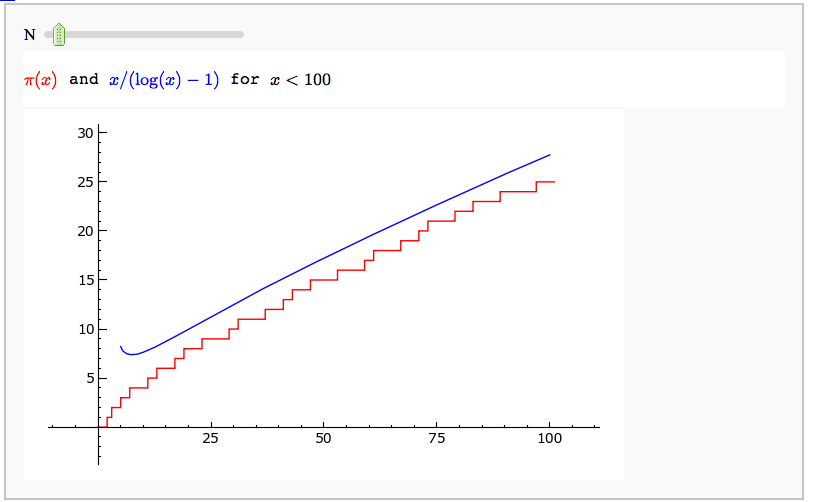
Prime Spiral - Square FIXME
by David Runde
Prime Spiral - Polar
by David Runde
Modular Forms
Computing modular forms
by William Stein
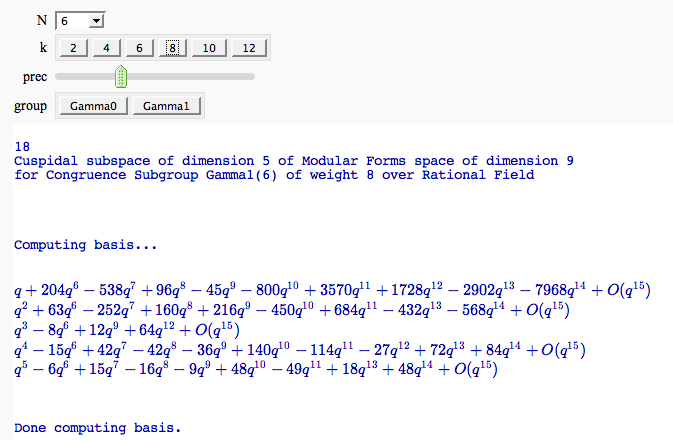
Computing the cuspidal subgroup
by William Stein
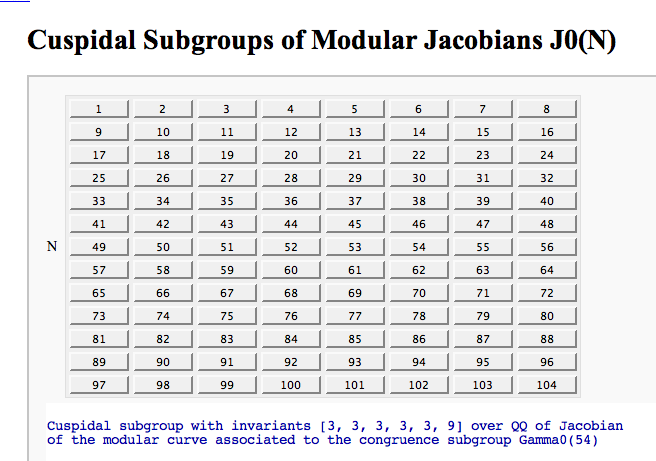
A Charpoly and Hecke Operator Graph
by William Stein
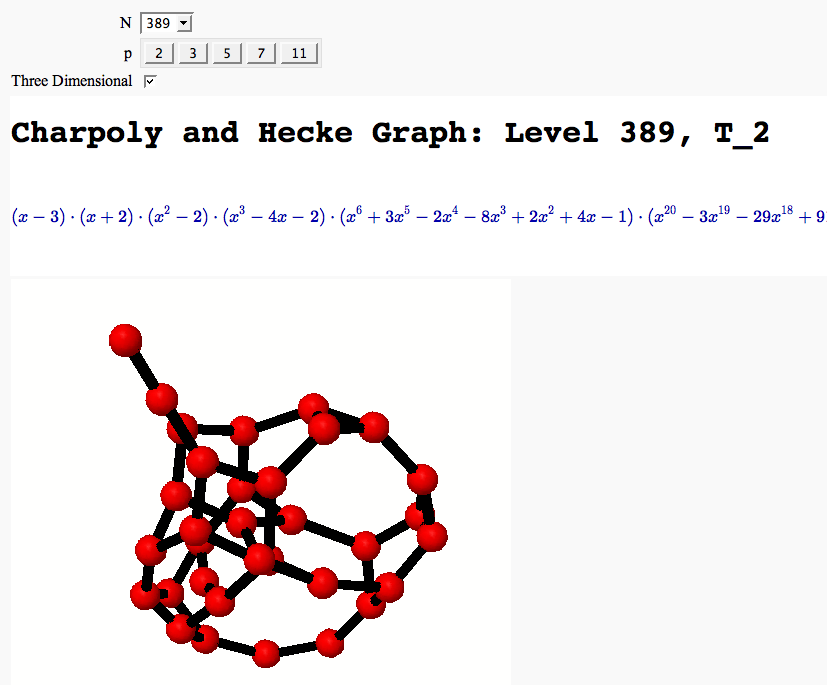
Modular Arithmetic
Quadratic Residue Table FIXME
by Emily Kirkman
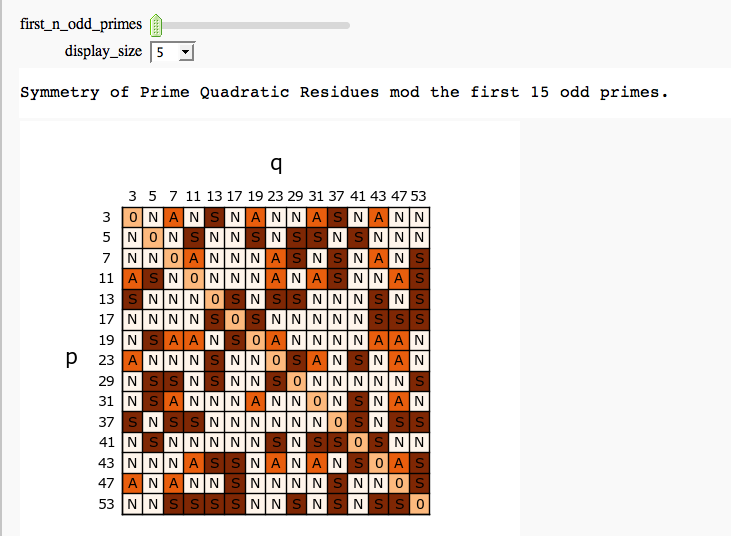
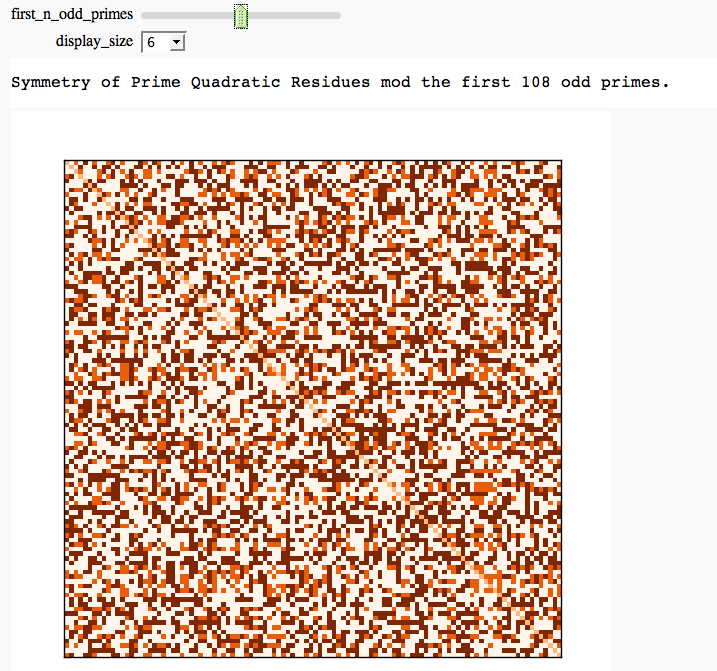
Cubic Residue Table FIXME
by Emily Kirkman
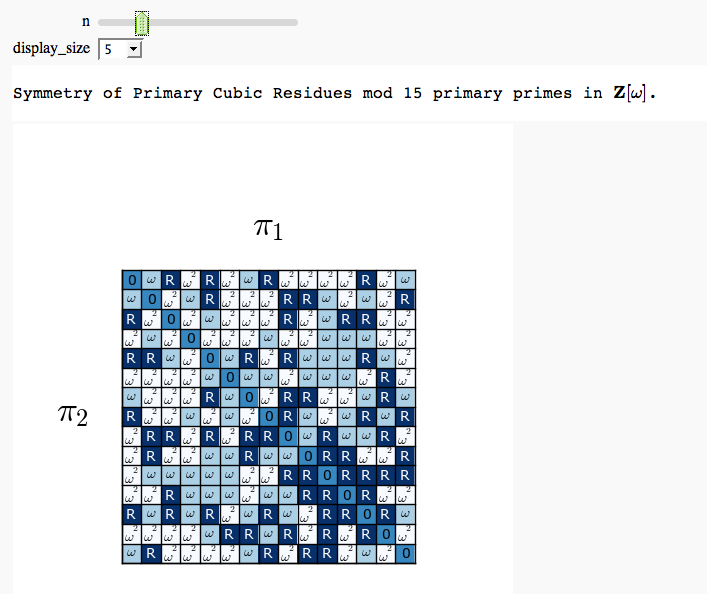
Cyclotomic Fields
Gauss and Jacobi Sums in Complex Plane
by Emily Kirkman

Exhaustive Jacobi Plotter
by Emily Kirkman
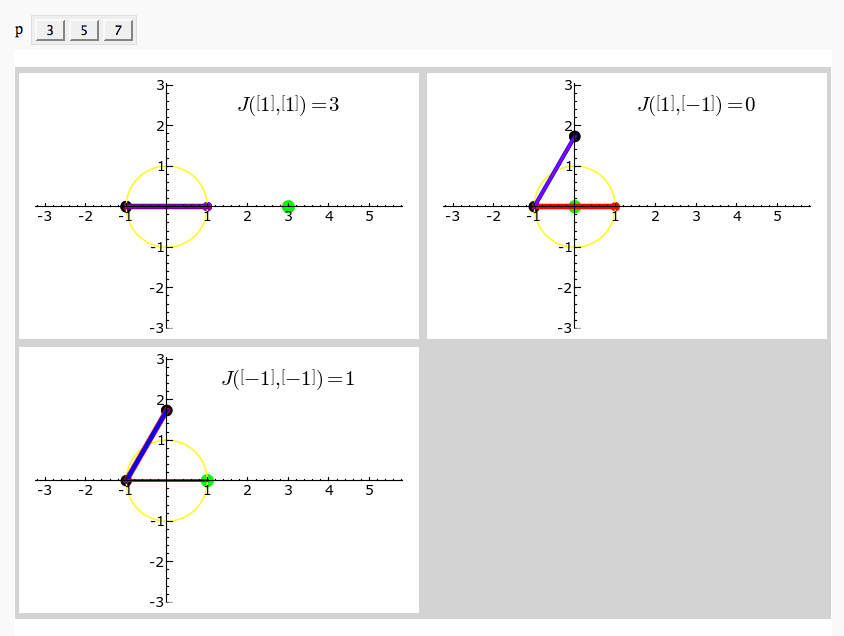
Elliptic Curves
Adding points on an elliptic curve
by David Møller Hansen
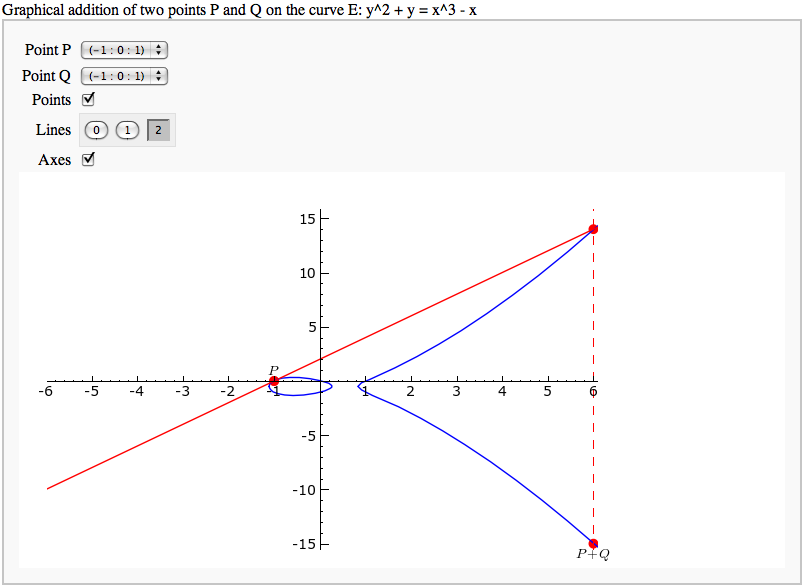
Plotting an elliptic curve over a finite field
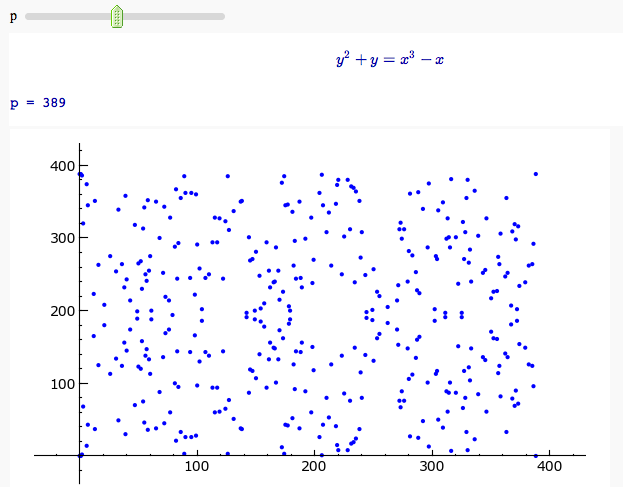
Cryptography
The Diffie-Hellman Key Exchange Protocol
by Timothy Clemans and William Stein
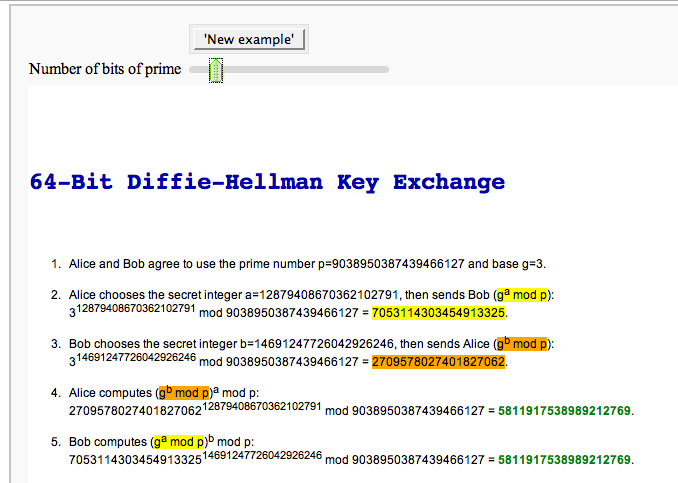
Other
Continued Fraction Plotter
by William Stein
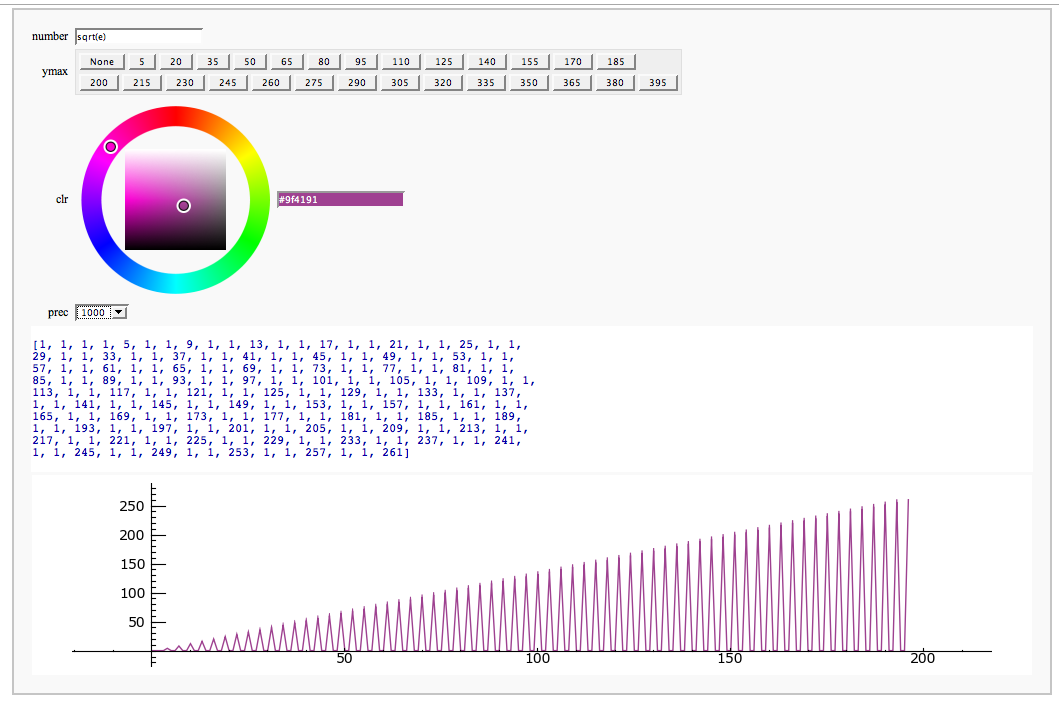
Computing Generalized Bernoulli Numbers
by William Stein (Sage-2.10.3)
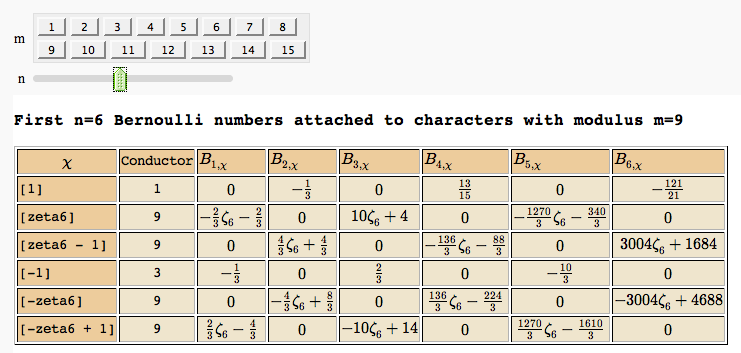
Fundamental Domains of SL_2(ZZ)
by Robert Miller
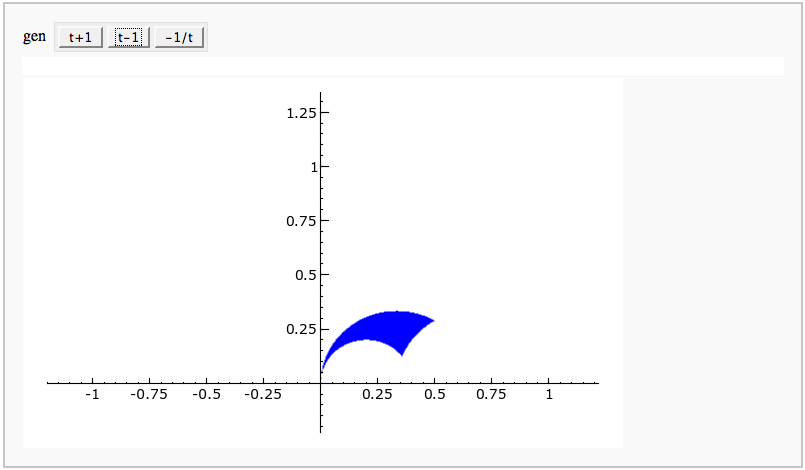
Multiple Zeta Values
by Akhilesh P.
Computing Multiple Zeta values (Euler-Zagier numbers)
Word Input

Composition Input

Program to Compute Integer Relation between Multiple Zeta Values (Euler-Zagier numbers)

Word to composition

Composition to Word

Dual of a Word

Shuffle product of two Words

Shuffle Regularization at 0

Shuffle Regularization at 1

